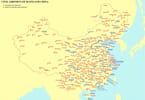The peak of the Eta Aquarid meteor shower is set for this week and favorable viewing conditions are in store for parts of the Southeast and Southwestern US.
The shower’s peak lasts from the evening hours of Tuesday, May 5, into the predawn hours of Wednesday, May 6, but meteors can still be seen several days before and after the peak, according to Slooh, a community observatory that has connected telescopes to the Internet for public use.
The Eta Aquarids take their name from the star Eta Aquarii in the constellation Aquarius. Due to the fact Aquarius sits south of the celestial equator, those in the southern hemisphere will be able to view as many as 30-60 meteors per hour, according to Slooh.
For northern stargazers, about half as many meteors will be seen near the peak, Slooh said.
Astronomy fans who will encounter inclement weather or cloudy skies can view Slooh’s live broadcast of the meteor shower on the night of May 5.
Slooh frequently airs live astronomy events by using its large network of community observatories from all around the world. After the event concludes, Slooh will show a replay of the event.
While many in the Southeast and Southwest will have optimal viewing weather, others throughout the U.S. will not be as fortunate.
Across the center of the nation, a slow-moving storm system that will first bring a flood threat and some severe thunderstorms to the southern High Plains later Monday into Tuesday, will prevent observers from getting a clear view, according to AccuWeather.com Senior Meteorologist Kristina Pydynowski.
Elsewhere, a cold front that will cut into the warmth moving into the Northeast for the start of the week will bring a band of showers and thunderstorms to parts of the Northeast, Pydynowski said.
Meanwhile, in the Pacific Northwest, a storm system bringing showers and thunderstorms will impede viewing opportunities, she added.
In addition to inclement weather, a bright waning gibbous moon will interfere with this year’s event, according to EarthSky.
Viewers can look anywhere in the sky to catch a glimpse of the meteors and the best time to observe will be an “hour or two” before dawn, EarthSky said.
WHAT TO TAKE AWAY FROM THIS ARTICLE:
- Elsewhere, a cold front that will cut into the warmth moving into the Northeast for the start of the week will bring a band of showers and thunderstorms to parts of the Northeast, Pydynowski said.
- Across the center of the nation, a slow-moving storm system that will first bring a flood threat and some severe thunderstorms to the southern High Plains later Monday into Tuesday, will prevent observers from getting a clear view, according to AccuWeather.
- The shower’s peak lasts from the evening hours of Tuesday, May 5, into the predawn hours of Wednesday, May 6, but meteors can still be seen several days before and after the peak, according to Slooh, a community observatory that has connected telescopes to the Internet for public use.






















